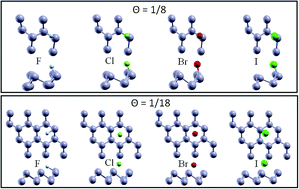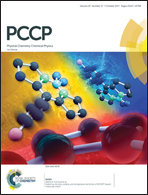First-principles studies on the effects of halogen adsorption on monolayer antimony†
Abstract
Using first-principles calculations, we carry out systematic studies on the electronic, magnetic and structural properties of halogenated β-phase antimonene. We consider two different levels of halogen adatom coverage i.e. Θ = 1/8 and Θ = 1/18. It is found that F, Cl and Br adatoms act as acceptors whereas the I adatom acts as a donor. For a high coverage of Θ = 1/8, halogenated β-phase antimonene exhibits metallic characteristics. With a lower coverage of Θ = 1/18, through the adsorption of F, Cl and Br the semiconducting unstrained antimonene becomes metallic. In contrast, I-adsorbed antimonene remains semiconducting but exhibits magnetic behavior. We further investigate the effects of bi-axial strain on the halogenated β-phase antimonene. It is found that bi-axial strain can only induce ferromagnetism on the halogenated antimonene at Θ = 1/18. However, the ferromagnetism is suppressed when the applied strain is high. We uncover that the emergence of strain-dependent magnetism is attributed to the presence of localized states in the bandgap resulting from collective effects of bi-axial strain and the adsorption of halogen atoms.



 Please wait while we load your content...
Please wait while we load your content...